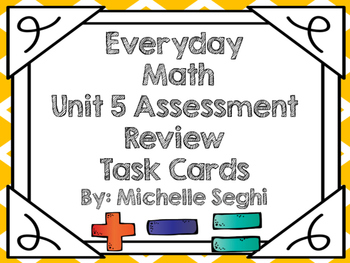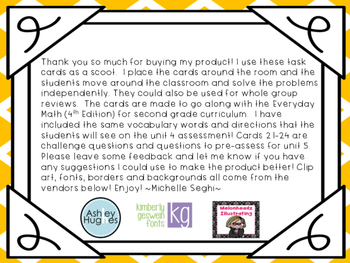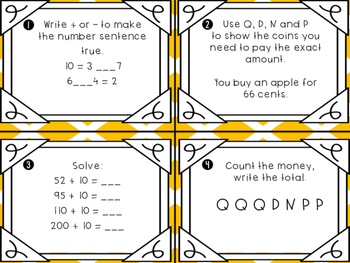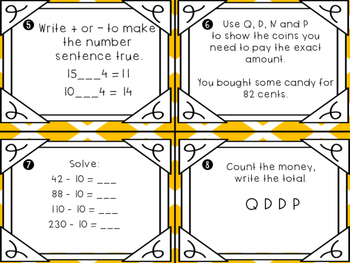Everyday Math Unit 5 Task Cards (Scoot)
Miss Seghi's Second Grade
80 Followers
Grade Levels
1st - 3rd
Subjects
Resource Type
Standards
CCSS2.MD.B.6
CCSS2.MD.C.8
CCSS2.NBT.B.5
CCSS2.NBT.B.7
CCSS2.NBT.B.8
Formats Included
- PDF
Pages
14 pages
Miss Seghi's Second Grade
80 Followers
What educators are saying
This was a perfect review before the test. It included a variety of skills. Got the kids up and moving! They loved it!
Description
These cards are made to go along with the Everyday Math (4th Edition) for second grade curriculum. I have included the same vocabulary words and directions that the students will see on the unit 5 assessment! Cards 21-24 are challenge questions and questions to pre-assess for unit 6. Concepts covered include: solving word problems counting coins, addition fluency, model word problems, adding and subtracting 10/100, mental math, adding multi digit numbers, using parts and total diagrams, using change diagrams, and using open number lines.
**Response sheet included**
**Answer Key included**
**Response sheet included**
**Answer Key included**
Total Pages
14 pages
Answer Key
Included
Teaching Duration
40 minutes
Report this resource to TPT
Reported resources will be reviewed by our team. Report this resource to let us know if this resource violates TPT’s content guidelines.
Standards
to see state-specific standards (only available in the US).
CCSS2.MD.B.6
Represent whole numbers as lengths from 0 on a number line diagram with equally spaced points corresponding to the numbers 0, 1, 2,..., and represent whole-number sums and differences within 100 on a number line diagram.
CCSS2.MD.C.8
Solve word problems involving dollar bills, quarters, dimes, nickels, and pennies, using $ and ¢ symbols appropriately. Example: If you have 2 dimes and 3 pennies, how many cents do you have?
CCSS2.NBT.B.5
Fluently add and subtract within 100 using strategies based on place value, properties of operations, and/or the relationship between addition and subtraction.
CCSS2.NBT.B.7
Add and subtract within 1000, using concrete models or drawings and strategies based on place value, properties of operations, and/or the relationship between addition and subtraction; relate the strategy to a written method. Understand that in adding or subtracting three-digit numbers, one adds or subtracts hundreds and hundreds, tens and tens, ones and ones; and sometimes it is necessary to compose or decompose tens or hundreds.
CCSS2.NBT.B.8
Mentally add 10 or 100 to a given number 100–900, and mentally subtract 10 or 100 from a given number 100–900.





